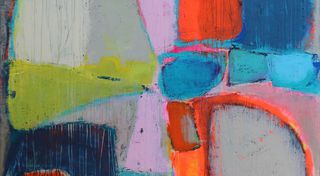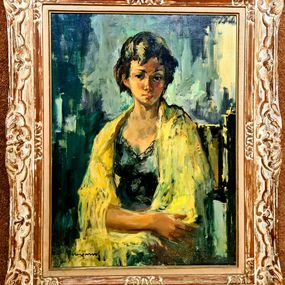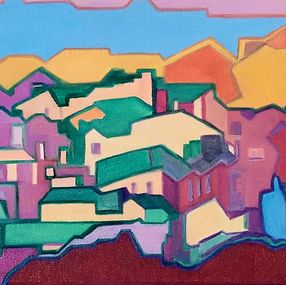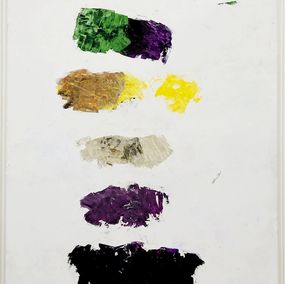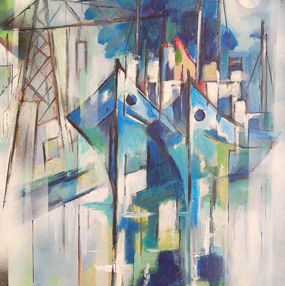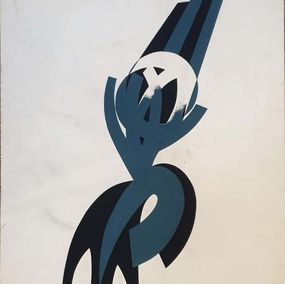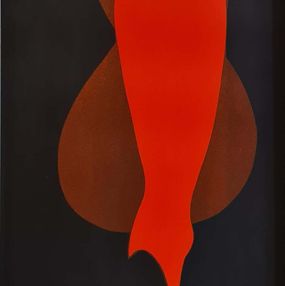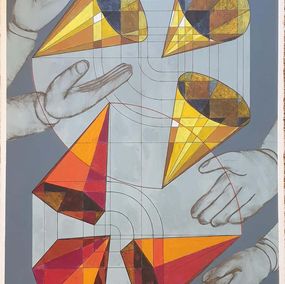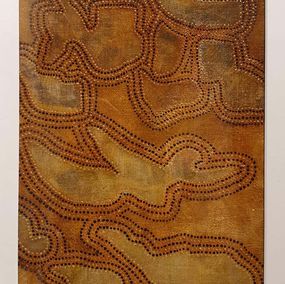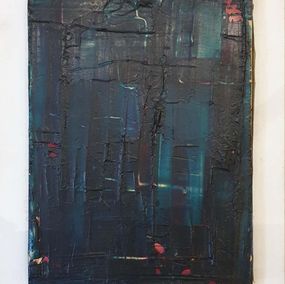
Portrait of a Fashionable Young Woman,
Circa 1950
Pere Modesto Luis Creixams
Painting : oil
73 x 54 x 2 cm 28.7 x 21.3 x 0.8 inch
One of the last works available by this artist
Free returns within 14 days
Authenticity guaranteed
Learn moreSecure payment
About the artwork
Type
Unique work
Signature
Hand-signed by artist
Authenticity
Sold with certificate of Authenticity from the gallery
Invoice from the gallery
Dimensions cm • inch
73 x 54 x 2 cm 28.7 x 21.3 x 0.8 inch Height x Width x Depth
Support
Framing
Beige ornate
Artwork dimensions including frame
94 x 76 x 5 cm 37 x 29.9 x 2 inch
Tags
Artwork sold in perfect condition
Artwork location: France
Mid 20th century oil on canvas portrait of stylish young woman by the noted Franco Spanish artist Pere Modesto Luis Creixams. The painting is signed bottom left and presented in a very fine Montparnasse patinated wood frame.
This charming and striking portrait captures a young woman seated confidently against an abstract backdrop inundated with rich blues and greens. Her figure is elegantly draped in a vibrant yellow shawl, which frames her quietly composed expression. Bold brushstrokes render the scene with both vigour and intimacy, creating a dynamic interplay of light and shadow. The artist's adept use of colour and texture imbues the painting with a sense of depth and realism, while maintaining an impressionistic style. The ornate frame complements the artwork's classical elegance, enhancing its timeless appeal. This piece stands out for its masterful combination of intense colour contrasts with a serene, contemplative subject, inviting viewers to explore the narrative depth and emotional resonance embodied in the woman's gaze.
Presentation
Pere Créixams (9 November 1893 – 1965) was a Spanish painter and illustrator. A figurative and self-taught painter, his work reflects both the sources of the School of Paris and Catalan painting. Throughout his life, he divided his time, between Spain, his native country, and France, his adopted country. Pere Créixams began his studies at the Escuela Moderna (the Modern School). He travelled in 1917 to Paris, in Montparnasse. He made his debut with François Bernouard, at La Belle Édition in 1917. The meeting with the writer Florent Fels was decisive. He introduced him to all of intellectual Paris: the poet, art critic and writer André Salmon who nicknamed him Pierre the Printer, the Swiss writer Blaise Cendrars, Max Jacob, André Malraux, Raymond Radiguet, André Salmon and the painter Amedeo Modigliani. Creixams continued his art under the advice of the painter Othon Friesz and it was the time of his first successes. He exhibited in 1921 at the Café du Parnasse and at the Galerie Montaigne in Paris. His portraits of women are marked by the style of the illustrious representative of the School of Paris, Amedeo Modigliani.
Florent Fels introduced him to the famous Parisian art dealer Paul Guillaume, who was located at 39, rue La Boétie. The latter offered to sign a contract to commit to delivering all his artistic production to him from November 1921 to June 1922. Creixams' paintings are exhibited alongside those of André Derain, Pablo Picasso, Maurice de Vlaminck, Henri Matisse and Amedeo Modigliani... Subsequently, Creixams worked with the gallery owner Pierre Loeb with whom he signed a contract in 1925. Located at the corner of Rue de Seine and Rue des Beaux-Arts, the famous Pierre Gallery which, from 1927 to 1963, represented many artists who marked the twentieth century (Braque, Klee, Chirico, Derain, Dufy, Gromaire, Léger, Miro, Pascin, Picasso, Soutine, Masson, Man Ray...) In painting, he turned to his Spanish ancestors, El Greco, Francisco de Goya, Diego Velázquez in order to affirm their artistic heritage. His admiration for Pablo Picasso was also felt in his production of the 1920s and he learned the lesson of the painter of the poor, the acrobats and the guitarists. From 1922, he settled in Montmartre and frequented the former members of the Bateau-Lavoir such as Pablo Picasso, Max Jacob, André Salmon. His friends in Florent Fels' literary circle supported him and Creixams then became friends with writers. The painter became an illustrator and collaborated with the writer and publisher duo Pascal Pia and René Bonnel on the unpublished poem by Charles Baudelaire, published from the original manuscript, which he adorned with eight etchings. In 1928, he exhibited at the Salon d'Automne and also took part in the Salon des Indépendants and the Salon des Tuileries.
Creixams made a name for itself by exhibiting in Parisian galleries and salons. (Salon des Indépendants, Salon d'Automne, Salon des Tuileries). In Paris, he befriended Catalan artists, like him exiled, or staying in the French capital, such as Joaquín Torres García, Eugenio d'Ors and Joan Miró. In Barcelona, in the same way, Creixams maintained friendships. His meeting with the critic and painter Rafael Benet opened the doors to the Barcelona artistic world. Creixams was a total success: he was presented in the city's avant-garde galleries, in salons and his works attracted the eye of collectors (Galeríe Dalmau, Sala Parés, Syra Art Galleries). He exhibits his works regularly at the Exposició de Primavera [Spring Exhibition], Saló de Montjuïc. Creixams' painting was first inspired by the Catalan noucentista. This movement, which began around 1906 and lasted until the beginning of the civil war in 1936, was artistic and political and proposed a renewal of society. Eugenio d'Ors, the theoretician of this new aesthetic, wanted an artistic regeneration in Catalonia. Then Creixams quickly evolved towards a popular and direct realism claimed by the new generation of artists called Generació del 17. His landscapes are very constructed, geometrized, the result of a great admiration for Paul Cézanne. Creixams' attachment to his country was manifested in regular visits to Catalonia throughout his life. The summer period was privileged and the small fishing village of Tossa de Mar welcomed the artist during many stays. These returns to Catalonia bring Creixams a new inspiration and a more personal style. Tossa, a haven of peace and a site of great beauty, became a real artistic and intellectual centre under his leadership. Creixams and Benet brought with them their Catalan friends: Emili Bosch Roger, Francesc Camps Ribera, Josep Gausachs, Francesc Domingo, Josep Mompou, Manuel Humbert, Emili Grau Sala, Enric Casanovas. But the attraction went beyond the Catalan borders thanks to the knowledge of the artist who invited his Parisian friends, writers, led by Florent Fels, Georges Charensol, Georges Duthuit and artists such as Albert Marquet, Roger Wild, Georges Kars and Marc Chagall. After spending the summer of 1934 in Tossa in the company of many artists, Creixams did not return to Paris and remained in Catalonia until 1937. In fact, he was appointed professor at the Escola Superior de Paisatge d'Olot. Then came the year 1937, marking a historical and political turning point for Catalonia and Spain. Creixams is artistically committed to the Republicans. It was at that time that the Catalan government chose him to illustrate a propaganda work published by the Commissariat de Propaganda de la Generalitat. He experienced the first armed clashes in Barcelona, but finally, as the situation deteriorated, he returned to live in Paris on February 20, 1937. He left Catalonia in the middle of the civil war and only returned after an eleven-year exile. Following his committed drawings, in 1939 he produced canvases illustrating the Retirada depicting the flight to France of thousands of Spanish Republicans. This return to France, during the Second World War, and the period of the Occupation were difficult. But Montmartre once again welcomed him with open arms and Creixams met up with his friends from the Butte, writers, painters and songwriters. He then became an essential figure in Montmartre alongside Marcel Aymé, Pierre Mac-Orlan, Gen Paul among others. The traditional party atmosphere that reigns in Montmartre suits the bon vivant character of Creixams perfectly. The distance from his native country for several years resulted in a painting with deep Spanish accents. Creixams,in 1938, again participated in the various Parisian salons. In addition, he exhibits as a Montmartre artist in group exhibitions but also alongside his Catalan compatriots. Regular solo exhibitions are devoted to him by Parisian galleries. (Delpierre Gallery, Petridès Gallery, Élysée Gallery, Charpentier Gallery...) Around 1940, Creixams met Nana de Herrera (1905-1991) and from their love was born a child, Ramon de Herrera. Nana de Herrera, a major figure in Parisian social life during the Roaring Twenties, is a Spanish classical ballet dancer. She was the model for Max Ponty for his design of the famous Gitanes cigarette packet (from the Seita). She also played a few film roles, both before and after the war. It is famous, among other things, for the portrait made by Tamara de Lempicka in 1928 at the request of the Austro-Hungarian Baron Raoul Kuffner. A distant echo of Joël Martel's advertisement that depicted her in a dance posture in 1926, Lempicka's painting seems to have been made to emphasize her personality. Creixams began a career as a society portraitist in the 1940s. He frequented the world of theatre and cinema. His favourite subjects are evocations of Spain. Gypsies, majas, dancers, bullfighters evolve between reality and fantasy. During the Occupation, Creixams frequented the Lapin Agile with the painter Gen Paul at 4, rue des Saules and the restaurants Chez Manière, rue Caulaincourt and Chez Pomme. At the end of the 1940s, Gen Paul invented his "Chignolle à Gégène", a sort of thunderous brass band, in which he would lead all the artists of Montmartre: Créixams, Frank-Will, Tony Agostini, Roger Bertin, Jean d'Esparbès...
More works from Galerie Bis & La Galerie Cotignac.
Artsper delivers internationally. The list of countries is available in the first step of your cart.
If your country is not listed contact us at [email protected] and we will see what we can do.
Note that Customs fees may apply for works shipped internationally. This is indicated in the first step of the shopping cart.
You can choose a delivery address different from the billing address. Make sure that a trusted person is present to receive the work if you cannot be there.
Have you purchased a painting, sculpture or work on paper?
Find our expert advice for the conservation and promotion of your works in the articles below:
Artsper offers you access to more than 200,000 works of contemporary art from 2,000 partner galleries. Our team of experts carefully selects galleries to guarantee the quality and originality of the works.
You benefit from:
-
Works at gallery price
-
Return within 14 days, regardless of your location
-
Easy resale of the work purchased on Artsper
-
Personalized research tools (selection and tailor-made universe)
Our customer service is available for any assistance.
At Artsper, our mission is to allow you to collect works of art with complete peace of mind. Discover the protections we offer at every stage of your shopping experience.
Buy works from top galleries
We work in close collaboration with carefully selected art galleries. Each seller on Artsper is carefully examined and approved by our team, thus ensuring compliance with our code of ethics. You therefore have the assurance of purchasing authentic, high-quality works.
Total transparency: you know what you are buying
Before being posted online, all artwork on Artsper is reviewed and validated by our moderation team. You can browse with complete peace of mind, knowing that each piece meets our criteria of excellence.
Personalized support: our experts at your service
Our team of contemporary art experts is available by phone or email to answer all your questions. Whether you want advice on a work or a tailor-made selection to enrich your collection, we are here to support you.
Resell your works with ease
If you have purchased a work on Artsper and wish to resell it, we offer you a dedicated platform to relist it. To find out more, click here.
Make offers with Artsper: negotiate like in a gallery
You have the possibility to propose a price for certain works, just like in a gallery. This feature allows you to initiate discussions and potentially acquire your coins at advantageous prices.
Get help with your negotiations
Our team will negotiate for you and inform you as soon as the best offer is obtained. Do not hesitate to call on our expertise to ensure a transaction at the best price.
Order securely
Artsper satisfaction assurance
We want you to be completely satisfied with your purchase. If the work you receive is not to your liking, you have 14 days to return it free of charge, and you will be refunded in full, whatever the reason.
Secure payment with Artsper partners
All credit card payments are processed by Paybox, the world leader in payment solutions. Thanks to their strict security standards, you can transact with confidence.
Problem Support
In the rare event that an artwork arrives damaged or not as described, we are here to help. Whether for a return, refund, restoration or exchange, our team will support you throughout the process and will ensure that we find the solution best suited to your situation.
Conditions to benefit from Artsper protections:
-
Use one of the payment methods available on Artsper for your order.
-
Report any problems within one week of receiving the work.
-
Provide required photographic evidence (including original artwork and packaging).
Artsper guarantees cover the following cases:
-
The received work lacks a described characteristic (for example, a signature or frame).
-
The artwork has significant differences from its description (e.g. color variation).
-
The work is damaged upon receipt.
-
The work is lost or damaged by the carrier.
-
Delivery is significantly delayed.
With Artsper, you collect with complete peace of mind.
